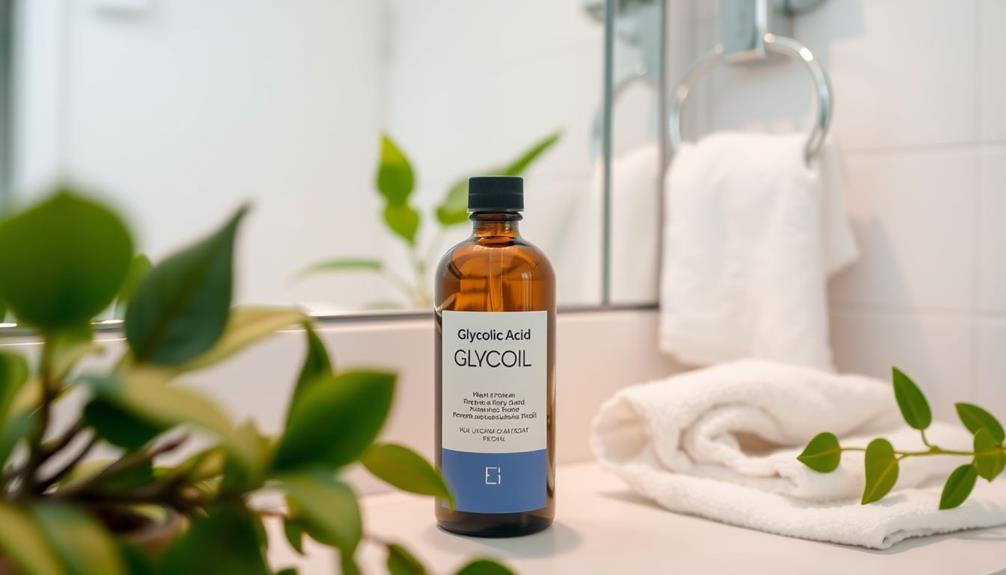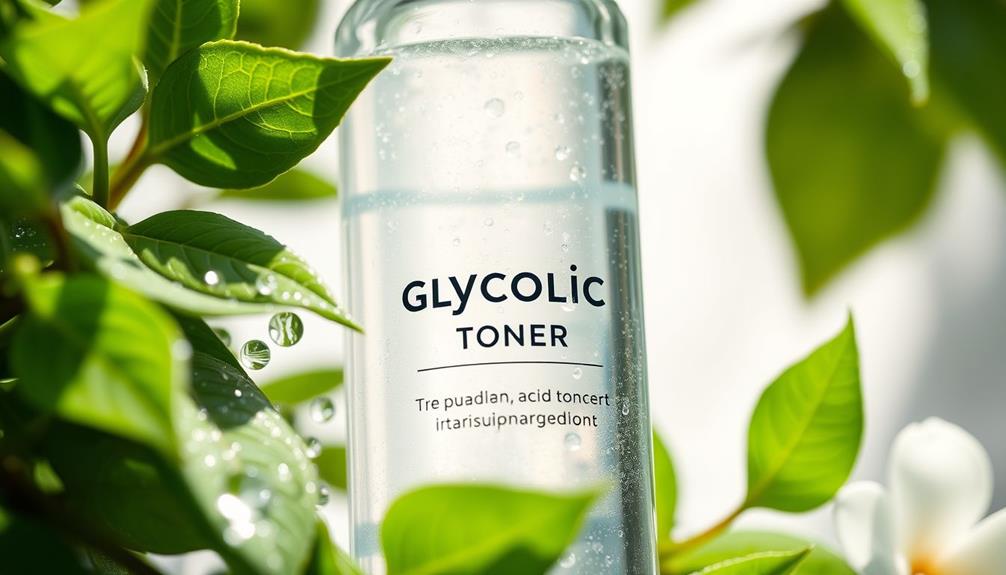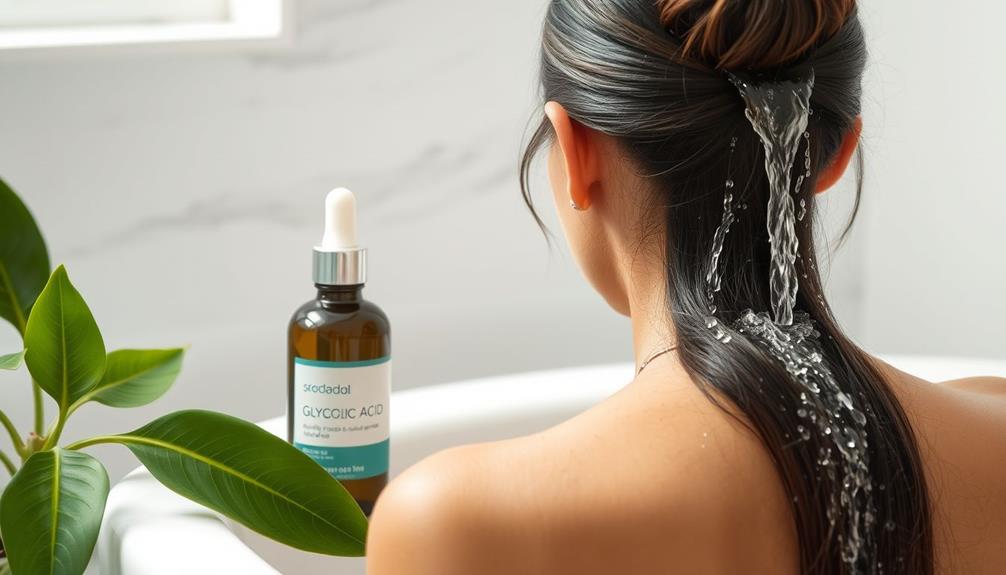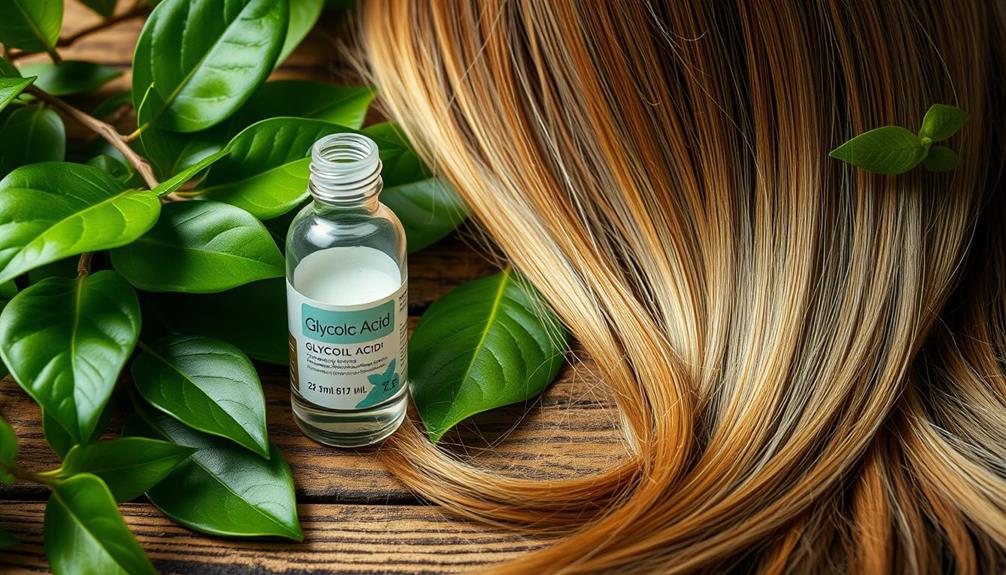Glycolic acid is an effective solution for treating acne and improving skin clarity. Dermatologists recommend starting with a lower concentration of 5-10% to test your skin’s reaction. This ingredient helps prevent clogged pores and encourages healthy cell turnover, resulting in fewer blemishes and smoother skin. It is best to apply it at night to reduce sun sensitivity, and remember to use a broad-spectrum sunscreen during the day. Use a good moisturizer after applying glycolic acid to keep your skin hydrated. There is still much to learn about its benefits and proper usage, so continue exploring for optimal results!
Key Takeaways
- Glycolic acid effectively prevents clogged pores and reduces pimples through its exfoliating properties.
- Dermatologists recommend starting with 5-10% glycolic acid for mild to moderate acne treatment.
- Regular use promotes healthy cell turnover, improving skin texture and clarity.
- Combining glycolic acid with a moisturizer can enhance hydration and minimize irritation.
Glycolic Acid and Acne Treatment

Glycolic acid's exfoliating properties make it a powerful ally in treating acne by preventing clogged pores and reducing pimples.
This alpha hydroxy acid effectively removes dead skin cells, promoting healthy cell turnover. By sloughing off these cells, it helps to clear out pores, preventing the formation of acne lesions.
Regular use of glycolic acid can lead to a noticeable improvement in overall skin texture, making your skin look smoother and more radiant.
Additionally, incorporating mindfulness practices, such as focusing on your skin's response during application, can enhance the results of your skincare routine, promoting a deeper connection with your body and self-exploration through body awareness techniques self-exploration through body awareness.
Dermatologists often recommend glycolic acid as a beneficial addition to your acne treatment routine, especially for those with mild to moderate acne.
It works on various skin types, but it's crucial to start with lower concentrations to gauge your skin's tolerance. This way, you can avoid any potential irritation while still reaping the benefits.
Moreover, glycolic acid not only clears active breakouts but also stimulates collagen production, which can help minimize the appearance of acne scars over time.
With its multifaceted action, glycolic acid can be a key component in your quest for clearer skin and improved skin texture.
Expert Recommendations and Guidelines

When incorporating glycolic acid into your skincare routine, experts recommend starting with a low concentration to assess your skin's tolerance and minimize irritation.
Essential oils for skin benefits like Tea Tree and Chamomile can be used in conjunction with glycolic acid to soothe any potential irritation.
Here are some key expert recommendations:
- Start Low and Slow: Begin with a 5-10% glycolic acid product to target acne without overwhelming your skin. Gradually increase the frequency from once a week based on your skin's response.
- Apply at Night: Use glycolic acid at night to reduce the risk of sun sensitivity. Always follow up with a broad-spectrum sunscreen during the day to protect your skin.
- Hydrate and Protect: After applying glycolic acid, use a moisturizer to maintain hydration and support your skin barrier. This helps counteract any potential dryness from exfoliating.
Myths and Misconceptions

Many people misunderstand glycolic acid, assuming it's only for aging skin or too harsh for sensitive types, but these myths overlook its broad benefits for all skin concerns. One common misconception is that glycolic acid solely targets the signs of aging. In reality, it effectively reduces dead skin cell buildup, making it a powerful tool for preventing acne.
Additionally, incorporating natural remedies like essential oils can enhance your skincare routine, providing complementary benefits for overall skin health essential oils for skin care.
Another myth is that glycolic acid dries out the skin. When used correctly, it can actually enhance hydration by boosting glycosaminoglycan production, which keeps your skin plump and moisturized.
For those worried about irritation, low concentrations of glycolic acid can benefit sensitive skin, helping with conditions like eczema and keratosis pilaris without causing significant discomfort.
Some people believe that glycolic acid thins the skin, but research indicates it can increase collagen density and improve overall skin thickness.
Finally, there's confusion about combining glycolic acid with other active ingredients. When integrated thoughtfully into your routine, particularly alongside moisturizers, it can be both effective and gentle, minimizing any potential irritation.
Embracing glycolic acid can lead to healthier, clearer skin for everyone.
Clinical Evidence and Studies

Research consistently supports glycolic acid's role in effectively treating acne, demonstrating its benefits through various clinical studies. As you explore treatment options, consider these key findings:
- Reduction in Acne Lesions: A study published in the Journal of the American Academy of Dermatology revealed that regular glycolic acid use markedly reduced acne lesions and improved overall acne severity.
- Improved Skin Texture: Research in the Journal of Cosmetic Dermatology showed that glycolic acid peels decrease sebum production and enhance skin texture, making it a powerful acne treatment. Additionally, maintaining a regular skincare routine that includes exfoliation can further enhance skin health and prevent breakouts, as noted in <a target="_blank" href="https://aplaceforanimals.com">cat care and environmental enrichment</a>.
- Addressing Post-Inflammatory Hyperpigmentation: Clinical trials indicate that glycolic acid is effective in reducing post-inflammatory hyperpigmentation (PIH), a common concern for those with acne-prone skin.
The exfoliating properties of glycolic acid promote cellular turnover, which helps prevent clogged pores—the main culprit behind acne formation.
Additionally, dermatological studies suggest that its anti-inflammatory effects contribute to fewer breakouts and improved skin clarity.
Best Practices for Use

To maximize the benefits of glycolic acid in treating pimples, it's important to follow best practices for its use.
Start with glycolic acid-containing products at a low concentration of around 5-10%. This minimizes irritation, allowing you to gradually increase usage to two or three times a week as your skin adapts.
Incorporating gentle skincare practices, such as yoga for back pain relief, can also enhance your overall skin health. Always perform a patch test before applying a new product fully to verify your skin can tolerate it.
Apply glycolic acid at night to reduce the risk of sun sensitivity, and don't forget to use a broad-spectrum sunscreen with at least SPF 30 during the day.
After applying glycolic acid, incorporate a hydrating moisturizer to support your skin barrier function and alleviate any dryness or irritation.
It's essential to avoid using glycolic acid with other strong exfoliants or active ingredients like retinol to prevent excessive irritation.
By following these guidelines, you can effectively harness the power of glycolic acid while maintaining healthy skin.
Frequently Asked Questions
What Do Dermatologists Say About Glycolic Acid?
Dermatologists say glycolic acid effectively exfoliates your skin, unclogs pores, and reduces inflammation. They recommend starting with lower concentrations to avoid irritation, especially if you've got sensitive skin. Always consult a professional for tailored advice.
Does Glycolic Acid Help Get Rid of Pimples?
You might think exfoliating can irritate your skin, but glycolic acid actually helps get rid of pimples. It unclogs pores and reduces inflammation, making it effective for treating active breakouts and preventing future ones.
Can You Put Glycolic Acid on a Popped Pimple?
You shouldn't apply glycolic acid on a freshly popped pimple. It might irritate the area and cause stinging. Wait until it starts healing, then use it to help prevent clogged pores and further breakouts.
What Percentage of Glycolic Acid Do Dermatologists Use?
Dermatologists typically use glycolic acid concentrations of 30% or higher for professional peels, while recommending at-home products with 5% to 10%. Always start low and gradually increase to avoid irritation and enhance skin tolerance.
Conclusion
Incorporating glycolic acid into your skincare routine can be a game-changer for tackling pimples.
As you explore its benefits and follow expert guidelines, you'll likely find your skin transforming in ways you didn't expect.
Remember, it's all about consistency and patience.
So, why not give it a try? You might just stumble upon the clear, radiant skin you've been dreaming of, all while enjoying the journey of discovery along the way!










